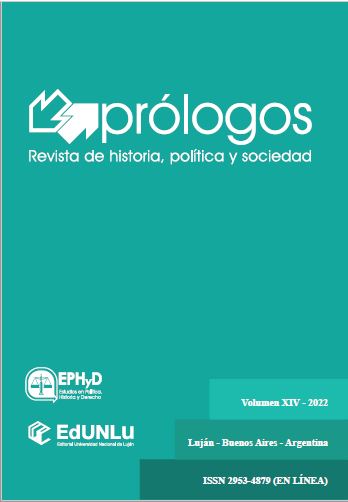"More is ceremony and external display than true punishment." On the Spanish possibilities for correcting unacceptable behaviors among the indigenous people of the reductions of Salta and Jujuy during the late colonial period.
Main Article Content
Abstract
The work is about the indigenous people placed in reductions in
the Chaco frontier of Salta and Jujuy between the end of the 18th century and
the beginning of the 19th century. It states that the Spaniards tried to achieve
order and “good police” among them. This implied that they subordinate
themselves to their “caciques”, to the “doctrineros”, to the commanders of
the forts and, fundamentally, to the authorities of the government and the
viceroyalty; that they remain gathered in the villages; and to work for their
living. The “caciques” has to enforce the rules imposed by the Spaniards and
punish -or help to punish- those who were unwilling to obey. No punitive
capacity was reserved, instead, for the priests: they had to act with love and
transform their neophytes through persuasion. To correct the insubordinate
or disobedient, they would count on the soldiers and commanders of the
garrisons, who were the ones who had jurisdiction over the indigenous
people and could use force against them. However, in practice they were
allowed to punish some behaviors. In these conditions, we will argue that it was very difficult to achieve the planned order within the reductions.
The Indian chiefs didn´t meet the expectations placed on them: the nature
of the cacical authority did not help in the execution of the Spanish project
either. The religious, who simultaneously used physical force and the force
of persuasion, did not achieve the order either. Finally, we will show that
the “hispanocriollas” authorities also saw their possibilities of discipline
conditioned, appealing to violence in strictly necessary cases, and acting
through example and conviction. Everything was due, in part, to the chronic
poverty of the towns, and to the defensive position they occupied, due to
the abandonment of the forts.
Article Details

This work is licensed under a Creative Commons Attribution-NonCommercial 4.0 International License.
References
Acevedo, E. (1965). La intendencia de Salta del Tucumán en el Virreinato
del Río de la Plata. Universidad Nacional de Cuyo. Facultad de
Filosofía y Letras. Instituto de Historia.
Bechis, M. (2008). Piezas de etnohistoria del sur sudamericano. Consejo
Superior de Investigaciones Científicas.
Clastres, P. (1987). Investigaciones en antropología política. Gedisa.
Cruz, E. (2007). Notas para el estudio de las rebeliones indígenas a fines
del período colonial en la frontera tucumana del Chaco (1781).
Anuario de Estudios Americanos, 14(2), 271-286.
Cutrera, M. L. (2022). “Un título desnudo de toda autoridad para mandar”.
Los caciques chaqueños y la experiencia reduccional tucumano
salteña (siglos XVIII-XIX). Anuario de Historia Regional y de las
Fronteras, 27(1), 153-181. DOI: https://doi.org/10.18273/revanu.
v27n1-2022005
Díaz Couselo, J. (2001). El ius commune y los privilegios de los indígenas
en América española. Revista de Historia del Derecho, 29, 267
Dobrizhoffer, M. (1967). Historia de los abipones Vol. I. Universidad
Nacional del Nordeste. Traducción de Edmundo Wernicke.
Farberman, J. (2004). Curacas, mandones, alcaldes y curas: legitimidad,
autoridad y coerción en los pueblos de indios de Santiago del
Estero, siglos XVII y XVIII. Colonial Latin American Historical
Review, 13(4), 367-397.
Glatstein, L. (2015). Resistencia y rebelión en la frontera y valles orientales
de Jujuy a fines del siglo XVIII: agentes, coyuntura y discursos
coloniales. Tesis de Licenciatura en Historia, Universidad Nacional
de Córdoba.
Glatstein, L. (2017). «Estando el fuego a las puertas». Acciones y
representaciones de la justicia colonial (Jujuy, 1781). Anuario
de Estudios Americanos, 74(2), 525-555. DOI: https://doi.
org/10.3989/aeamer.2017.2.05
Gullón Abao, A. (1993). La frontera del Chaco en la gobernación del
Tucumán, 1750-1810. Servicio de Publicaciones Universidad de
Cádiz.
Harris, M. (1993). Jefes, cabecillas y abusones. Alianza.
Jurado, C. (2014). Un fiscal al servicio de su majestad: Don Francisco de
Alfaro en la Real Audiencia de Charcas, 1598-1608. Población &
sociedad, 21(1), 99-132.
Lázaro Ávila, C. (1999). Conquista, control y convicción: el papel de
los parlamentos indígenas en México, el Chaco y Norteamérica.
Revista de Indias, LIX(217), 645-673. https://revistadeindias.
revistas.csic.es/index.php/revistadeindias/article/view/831/900
Levaggi, A. (1998). Manual de Historia del Derecho Argentino. Depalma.
Tomo I.
Oyarzábal, M. (2013). Los caminos de las palabras. La incidencia de las
Ordenanzas de Alfaro en la jurisdicción de Jujuy, siglo XVII.
Anuario del Instituto de Historia Argentina, 13.
Roca Mones-Ruiz, C. G. (2017). Ordenanzas del Señor Oidor y Visitador
de esta Gobernación, el Licenciado Don Francisco de Alfaro.
Revista Cruz del Sur, VII(26), 385-458.
Sahlins, M (1963). Poor Man, Rich Man, Big-Man, Chief: Political Types
in Melanesia and Polynesia. Comparative Studies in Society and
History, 5(3), 285-303.
Sica, G. (2014). Las otras mitas. Aproximaciones al estudio de la mita de
plaza en la jurisdicción de Jujuy, gobernación de Tucumán, sigloXVII. Anuario de Estudios Americanos, 71(1), 201-226.
Tau Anzoátegui, V. (1983). ¿Qué fue el Derecho Indiano? Abeledo-Perrot.
Vitar, B. (1997). Guerra y misiones en la frontera chaqueña del Tucumán
(1700-1767). Consejo Superior de Investigaciones Científicas.
Otras fuentes
Recopilación de Leyes de los Reinos de las Indias. https://www.boe.es/
biblioteca_juridica/publicacion.php?id=PUB-LH-1998-62

